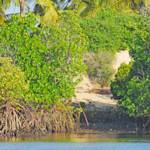Hamoun Wetlands now a wasteland
2023 CE • Western Asia
"For five millennia, under the banners of nearly a dozen empires, through the preachings of countless religions, and amidst the technological marvels of the modern age, the Hamoun wetlands stood as a major source of food and shelter for the people of Central Asia. Located on the border of present-day Afghanistan and Iran and fed by the Helmand River, the 2,000-square-kilometer (800-square-mile) wetlands formed a true oasis in the middle of hundreds of kilometers of arid plains. The wetlands provided those around them with an abundant source of fish, game, and fresh water for farming. Their dense marshes and clear lakes supported all manner of wildlife from carp to otter to leopard. Their location far from any other substantial body of fresh water made them an ideal stop for migrating birds traveling south to the Indian Ocean. Within the past five years, however, the once fertile wetlands have deteriorated rapidly. Irrigation expansion throughout the 20th century coupled with one of the worst droughts ever witnessed in Central Asia have left the Hamoun nearly as arid as their surroundings. The wetlands have been replaced mostly by lifeless salt flats and decaying reed stands. The wildlife, the towns, the fisheries, and the agriculture that once surrounded the Hamoun have all fallen away, giving rise to a wasteland . . . The combination of drought and the massive irrigation proved to be too big of a shock to the wetlands. The local fish and bird populations all but disappeared. Animals that could not sustain themselves in the desert or make the long journey to another oasis died. Winds that were once cooled by the waters of the wetlands now blew dust, sand, and salt from the lakebeds onto the surrounding villages."
John Weier, "From Wetland to Wasteland: The Destruction of the Hamoun Oasis," NASA Earth Observatory, December 13, 2002.
Fars Media Corporation, CC BY 4.0, via Wikimedia Commons


Learn about Maya Lin’s fifth and final memorial: a multi-platform science based artwork that presents an ecological history of our world - past, present, and future.

Discover ecological histories and stories of former abundance, loss, and recovery on the map of memory.

Learn how we can reduce our emissions and protect and restore species and habitats – around the world.

See how art can help us rethink the problems we face, and give us hope that each one of us can make a difference.

Help make a global memorial something personal and close to home. Share your stories of the natural world.


